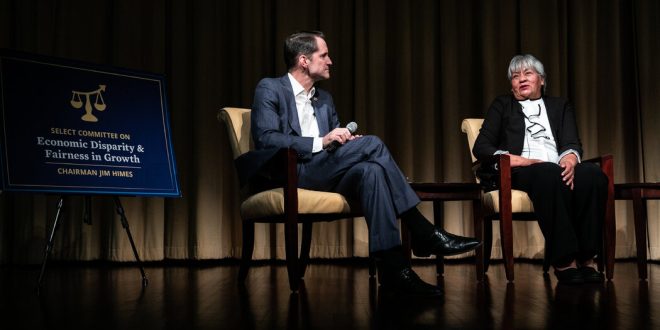WASHINGTON — Standing in an empty kitchen, Alicia Villanueva, a 61-year-old Mexican immigrant living in Brentwood, Calif., is overcome with grief as she reflects on her small tamale-making business, brought to a halt because of the coronavirus pandemic.
With the help of local organizations, she had expanded her operation from an under-the-table enterprise that brought in $20 a day into one that produced a steady stream of income, but now she’s worried about making ends meet.
“Everything disappeared,” Ms. Villanueva says. “We lost everything.”
Ms. Villanueva is effectively a witness offering testimony on behalf of a House select committee convened during the pandemic to look at the economic disparities facing Americans. But she is not reciting a statement from a table in a polished hearing room on Capitol Hill; she is featured in a gritty, documentary-style film produced to drive home the panel’s findings, a modern take on the traditional work of a congressional committee.
Lawmakers, aides and families gathered in a theater at the National Archives on Tuesday to screen the 30-minute film, narrated by the Emmy-winning actress Sarah Jessica Parker and produced by the House Select Committee on Economic Disparity and Fairness in Growth.
“Grit & Grace: The Fight for the American Dream” was directed and produced by Oscar Guerra, an Emmy-winning producer with the PBS program “Frontline,” and features the stories of three Americans, including Ms. Villanueva.
The project, which cost $200,000, was an effort to break through polarization and allow the personal stories of struggling Americans to address the “political rage” across the United States over the economy, said Representative Jim Himes, Democrat of Connecticut and chairman of the committee.
“Congress has traditionally been awful at speaking to the American people,” Mr. Himes said in an interview. “We’re awful because we run partisan talking points, which in my experience, very few Americans want to hear.”
A New U.S. Congress Takes Shape
Following the 2022 midterm elections, Democrats maintained control of the Senate while Republicans flipped the House.
Instead, Mr. Himes said, the film was “an opportunity to hear, to tell the stories of Americans and to try to collapse some of the stereotypes that exist.”
The committee’s presentation of its final report alongside a film was a break with the past in an institution built on tradition. It was the latest move by a Democratic-led Congress in an increasingly divided media landscape to try to find new ways to speak to Americans.
In recent months, the House select committee investigating the Jan. 6, 2021, attack on the Capitol has broken the mold of the traditional congressional hearing with its slickly produced visual and auditory presentations.
The economic panel’s documentary was released in tandem with its final report, which had policy recommendations that included investing in early education and affordable housing in communities.
Representative Bryan Steil, Republican of Wisconsin, said the committee had embraced ideas from both political parties.
“We’re going to enter a period of time of divided government for the next two years,” Mr. Steil said. “The areas where we can find common ground to address some of the biggest challenges we face — this is our moment.”
The inspiration for the film project came from the work of Roy E. Stryker, who, as chief of the historical section of the Farm Security Administration from 1935 to 1943, directed photographers who documented America during the Great Depression, producing some of the most definitive portraits of the era.
Over four months, Eric Harris, the committee aide who ran the project, interviewed about 150 people across the country to find three who would be featured. When Mr. Harris made the final decision, he said he was looking for “stories of triumph and defeat” and “stories of dignity.”
One of those was Joseph Graham Jr., a 50-year-old Black man from North Carolina, who was unable to finish college because his family could not afford it.
As an adult, Mr. Graham, a single parent of four, went back to school and now runs a company focused on equity. He described his struggles with returning to school and weight gain after the death of his parents, and was depicted on college campuses and running in a weighted vest given to him by his children.
The film also introduces the Cook family of West Virginia, where Wendy, 50, and Jeremy, 45, take care of two sons with special needs and run an antique shop that was shuttered during the pandemic. Although they were able to adapt by using social media to livestream auctions, they faced significant challenges as the internet connection in their home in rural West Virginia often cut out.
“I’m hoping this helps bring some empathy and compassion across both sides of the aisle,” Mr. Cook said in an interview.
The film struck an emotional chord for some viewers, like Taliah Givens, a small-business owner in New Jersey and a friend of Mr. Graham.
One question stood out to her after watching the film: “How can our congressional leaders uplift us, and not necessarily give a hand out, but a hand up?”
 Top Naija News: Nigerian News, Breaking News Nigeria and World News Top Naija News is a daily news publication in Nigeria, delivering the latest breaking news in Nigeria and around the world.
Top Naija News: Nigerian News, Breaking News Nigeria and World News Top Naija News is a daily news publication in Nigeria, delivering the latest breaking news in Nigeria and around the world.




